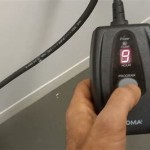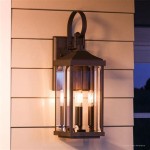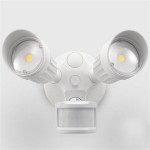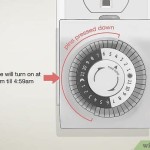Outdoor Sensor Light Won't Turn On: Troubleshooting Guide
Outdoor sensor lights provide security and convenience by automatically illuminating designated areas upon detecting movement. However, encountering a non-functional outdoor sensor light can be frustrating and compromise the intended security benefits. Systematic troubleshooting is crucial to identify the root cause and restore the light's functionality. This guide provides a detailed approach to diagnosing and resolving common issues when an outdoor sensor light fails to activate.
Power Supply Issues
The first step in troubleshooting a non-functional outdoor sensor light involves verifying the power supply. A lack of power is the most frequent cause of inactivity. Initially, inspect the circuit breaker or fuse controlling the outdoor lighting circuit. An indicator of a tripped breaker is its switch being in the “off” or middle position. Resetting the breaker by switching it fully to the “off” position and then back to the “on” position can resolve the issue. If the breaker trips again immediately, it suggests a short circuit within the lighting circuit, necessitating further investigation by a qualified electrician.
If the circuit breaker is not the problem, examine the light fixture's wiring. Loose or corroded connections can interrupt the power flow. Turn off the power at the breaker before inspecting any wiring. Use a voltage tester to confirm that power is reaching the fixture. If no voltage is detected, the problem lies upstream, possibly in the wiring between the breaker and the fixture. A visual inspection of the wiring for any signs of damage, such as frayed insulation or exposed wires, is essential. If any damaged wiring is discovered, it must be replaced or repaired by a qualified electrician.
Another potential issue related to the power supply is a faulty transformer, particularly if the outdoor sensor light is part of a low-voltage landscape lighting system. Transformers convert standard household voltage to a lower voltage required by the lights. If the transformer fails, the lights will not receive power. Testing the transformer's output voltage with a multimeter can determine if it is functioning correctly. If the transformer output is significantly lower than its rated voltage or non-existent, it likely needs replacement.
Motion Sensor Problems
If the power supply is confirmed to be functional, the next area of focus is the motion sensor itself. These sensors rely on detecting changes in infrared radiation caused by movement. Several factors can inhibit the sensor's ability to detect motion effectively.
Obstructions blocking the sensor's field of view are a common cause. Overgrown vegetation, such as trees or bushes, can physically obstruct the sensor, preventing it from detecting movement. Similarly, accumulated dirt, dust, or debris on the sensor lens can reduce its sensitivity. Regularly cleaning the lens with a soft, damp cloth is crucial for maintaining optimal performance. It is also prudent to trim back any vegetation that may be interfering with the sensor's range and field of view.
Sensitivity settings play a significant role in how the sensor reacts to movement. Most outdoor sensor lights have adjustable sensitivity settings that allow the user to fine-tune the sensor's response. If the sensitivity is set too low, the sensor might not detect smaller movements or movements occurring further away. Conversely, if the sensitivity is set too high, the sensor may be triggered by insignificant events, such as small animals or swaying branches, leading to frequent and unnecessary activations. Adjusting the sensitivity dial or switch to an appropriate level can optimize the sensor's performance. The manufacturer's instructions will contain guidance on setting appropriate sensitivity levels based on needs of the given location.
Older motion sensors may simply fail over time due to component degradation. In such cases, the sensor itself needs to be replaced. If the sensor is integrated into the light fixture, replacing the entire fixture might be the most cost-effective solution. Some newer fixtures offer replaceable sensors, which can be a more economical repair option. Before replacing the sensor, ensure that all other potential causes have been ruled out to avoid unnecessary expenses. Check the light fixture's warranty, as some manufacturers offer coverage for sensor failures within a specified period.
Another possible factor is the sensor's location relative to heat sources. Motion sensors are sensitive to temperature changes. Placing the sensor near a heat source, such as an exhaust vent or a reflective surface that intensifies sunlight, can interfere with its ability to accurately detect human movement. The sensor might misinterpret the heat as constant activity, rendering it unable to trigger the light effectively, or it may become desensitized altogether. Relocating the sensor or shielding it from direct heat sources can mitigate this issue.
Light Bulb and Wiring Issues
Even if the power supply and motion sensor are functioning correctly, a faulty light bulb or wiring problem within the fixture can prevent the light from turning on. Start by inspecting the light bulb itself. A burned-out bulb is an obvious cause of failure. Replacing the bulb with a new one of the correct wattage and type is a simple but effective solution.
However, even if the bulb appears intact, it may still be defective. To rule out a faulty bulb, test it in another known-working fixture or use a multimeter to check its continuity. A bulb with no continuity is definitely burned out and needs replacement. When replacing the bulb, also inspect the bulb socket for any signs of corrosion or damage. Clean any corrosion with a wire brush or contact cleaner. A damaged socket might need to be replaced to ensure proper contact with the bulb.
Wiring problems within the light fixture are another potential cause. Check the wiring connections inside the fixture for any signs of looseness, corrosion, or damage. Turn off the power at the breaker before inspecting any wiring. Loose connections can be tightened with a screwdriver. Corroded wires should be cleaned or replaced. Any damaged wires should be replaced by a qualified electrician. Ensure that all wiring connections are secure and properly insulated to prevent short circuits.
The type of bulb used in the fixture can also impact its performance. Some older motion sensor lights are not compatible with certain types of LED bulbs. Using an incompatible bulb can cause the light to flicker, fail to turn on, or damage the sensor. Refer to the light fixture's specifications or the manufacturer's instructions to determine the appropriate bulb type. Ensure the replacement bulb is compatible with the fixture's voltage and wattage requirements. Newer fixtures are generally more compatible with a wider range of LED bulbs, but it is still crucial to verify compatibility before installation.
Photoelectric cells, often integrated with motion sensors, can also contribute to lighting malfunctions. These cells detect ambient light levels and prevent the light from activating during daylight hours. If the photoelectric cell is faulty or blocked, it might incorrectly sense daylight even at night, preventing the light from turning on. Inspect the photoelectric cell for any obstructions, such as dirt, debris, or paint. Clean the cell with a soft, damp cloth. If the photoelectric cell is malfunctioning, it may need to be replaced. In some fixtures, the photoelectric cell can be disabled or bypassed, allowing the light to operate regardless of ambient light levels. This function may be described in the product manual.
Addressing these potential issues systematically will help pinpoint the cause of the problem and restore the functionality of the outdoor sensor light. When working with electrical wiring, safety precautions are paramount. If there's uncertainty about any aspect of the wiring or electrical system, consult a qualified electrician for assistance. Attempting repairs without adequate knowledge can be dangerous and lead to further damage or injury.

Here S Why Your Motion Sensor Lights Aren T Turning On Us Electric

Motion Activated Lighting Repairs Won T Turn Off
My Outdoor Security Light Won T Turn Off George Brazil Plumbing Electrical Phoenix Az

My Motion Sensor Light Is Not Working Ehow

My Flood Lights Won T Turn Off Ehow

Why Does My Motion Sensor Light Keeps Coming On And Won T Turn Off Rayzeek
Lutron Maestro Light Won T Turn On Diy Home Improvement Forum

How To Stop A Motion Sensor Light From Turning Off Rayzeek

Outdoor Security Light Troubleshooting Ehow

Motion Sensor Controlled Light Won T Turn Off Again Flows Homey Community Forum







